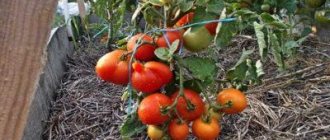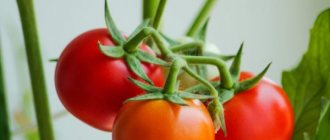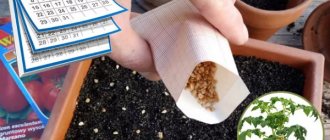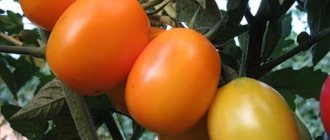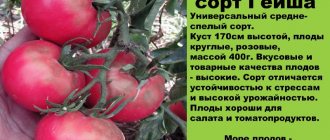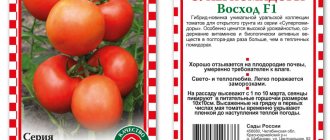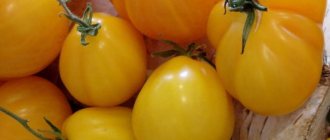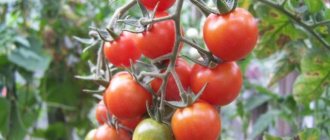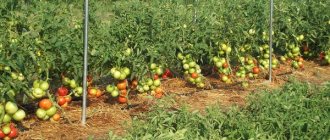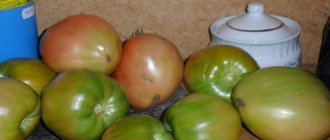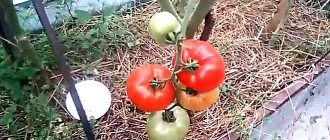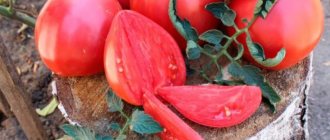Tomatoes Perseus: variety description
| Variety name | Perseus |
| general description | Mid-season determinate variety |
| Originator | Moldova |
| Ripening period | 108-115 days |
| Form | Round, slightly flattened |
| Color | Red |
| Average weight of tomatoes | 110-180 grams |
| Application | Fresh, for preservation |
| Productivity of the variety | 6-8 kg per sq.m |
| Features of cultivation | Standard agricultural technology |
| Disease resistance | Resistant to many diseases |
The Perseus tomato variety belongs to the determinate mid-early varieties.
Its homeland is Moldova, it was bred at the end of the 19th century. The height of the bushes of this plant usually reaches fifty to sixty centimeters; they do not form a standard. The bushes are characterized by good foliage, and their first inflorescence is usually located above the sixth or seventh leaf. Perseus tomatoes are resistant to fusarium, alternaria, anthracnose and tobacco mosaic virus. They can be grown in open ground and in greenhouses.
Description of the fruit
- The fruits of this type of tomato have a flat-round shape.
- The weight of one fruit is from one hundred ten to one hundred eighty grams.
- They are covered with a dense red peel, and have a small green spot near the stalk.
- The fruits have a pleasant taste and good commercial quality.
- Transportation is well tolerated. These tomatoes are stored for a long time, so they can be transported over long distances.
- The number of chambers in these fruits ranges from five to seven, and the dry matter content is quite low.
The fruits of these tomatoes can be eaten fresh or canned.
You can compare the weight of the fruits of the variety in the table below:
| Variety name | Fruit weight |
| Perseus | 110-180 grams |
| Monomakh's hat | 400-550 grams |
| Pink King | 300 grams |
| Black pear | 55-80 grams |
| Icicle Black | 80-100 grams |
| Moscow pear | 180-220 grams |
| Chocolate | 30-40 grams |
| Sugar Pudding | 500-600 grams |
| Zhigalo | 100-130 grams |
| Golden domes | 200-400 grams |
Characteristics
The main advantages of Perseus tomatoes can be called:
- Heat resistance.
- Transportability.
- Large fruit.
- Good taste of the fruit.
- Disease resistance.
This variety of tomatoes has virtually no disadvantages, which is why it is a favorite of many gardeners. The Perseus tomato variety has good yield. From six to eight kilograms of fruits are collected from one square meter of planting. From the emergence of seedlings to the ripening of the Perseus tomato fruit, it usually takes from one hundred eight to one hundred fifteen days. The fruits form quickly and ripen almost simultaneously.
You can compare the yield of this variety with others in the table:
| Variety name | Productivity |
| Perseus | 6-8 kg per square meter |
| Aurora f1 | 13-16 kg per square meter |
| Leopold | 3-4 kg per bush |
| Sanka | 15 kg per square meter |
| Argonaut f1 | 4.5 kg per bush |
| Kibitz | 3.5 kg per bush |
| Heavyweight of Siberia | 11-12 kg per square meter |
| Honey cream | 4 kg per square meter |
| Ob domes | 4-6 kg per bush |
| Marina Grove | 15-17 kg per square meter |
Planting seedlings in the soil
It is recommended to plant tomatoes in the soil after zucchini, cabbage and pumpkin. You should not plant tomatoes in the same place for more than two years in a row. When the ground warms up by more than 14 degrees at a depth of 15 cm, you can begin planting seedlings. This process usually begins in early June.
Humus and wood ash are added to the prepared holes, and then a peat pot with seedlings is placed. The upper part of the pot with seedlings is sunk 4–5 cm into the soil. This is especially necessary if the plant is too elongated.
Features of cultivation
Perseus tomatoes can be grown in almost any region of Russia, as well as in Moldova, Belarus and Ukraine. This heat-loving crop is usually grown in open ground by sowing or seedlings. To obtain seedlings, seeds should be sown between March 1 and March 10 in pots measuring ten by ten centimeters filled with a nutrient mixture.
After fifty-five to sixty days, the seedlings are planted in the garden. This usually happens in the second ten days of May. If you want to get an early harvest, plant the seedlings in the beds in early May and cover them with film until it gets warmer outside.
These tomatoes will grow best in loamy soil enriched with organic fertilizers. For planting, choose a sunny place, protected from strong winds. The distance between plants and between rows should be fifty centimeters.
Requirements for seed material
Particular attention should be paid to the quality of the seeds that will be used to grow seedlings. Some people buy seeds in stores. The description of the Perseus tomato indicates that this is not a hybrid variety, therefore, it can be successfully grown as seedlings from seeds collected from your own plot. To do this, the healthiest bush is selected, on which the fruit of the most regular shape and large size is left. It is better if the fruit that is left for seed grows on the first ovary from the ground.
Ripe Perseus tomatoes, intended for collecting seeds from them, are laid out in one layer on a flat surface for final ripening. Then the seeds are selected from them, washed in water and placed on a sieve to drain the water.
The seeds are laid out on a sheet of paper to dry, and then placed in paper envelopes for storage. It is advisable to make an inscription on the bag about the variety and date of preparation. Tomato seeds that are stored for more than 5–6 years lose their viability.
Oregano: beneficial and medicinal properties. Uses and contraindications of oregano
Soil for sowing seeds can be purchased in specialized stores or prepared with your own hands. To do this, add compost and humus to the soil dug up in the garden.
It is advisable to take soil on which nightshade crops have not been planted for several years. To disinfect the soil, water it with a slightly pink solution of manganese.
Purchased soil has the following advantages over garden soil:
- There are no pathogens, including fungal ones, that usually affect plants.
- Much lighter than garden wood and less dense.
- Some soils are enriched with photobacteria, which have a protective function for seedlings.
- The soil from the package is balanced in nutrients.
- When using, there is no need to prepare it in advance and store it indoors for a long time.
- It is inexpensive and can be purchased in the required packaging.
They begin to sow seeds taking into account the fact that seedlings will have to be planted in open ground after 2 months. If seedlings are planted in greenhouses, you can plant the seeds 2 - 3 weeks earlier.
Diseases and pests
Perseus tomatoes are highly resistant to many diseases. To protect the plants as much as possible, treat them with a solution of potassium permanganate five to six days after planting, and before flowering, carry out preventive spraying with fungicidal preparations.
Try growing Perseus tomatoes, and your family will enjoy delicious and healthy tomatoes all summer long.
| Mid-season | Mid-early | Late ripening |
| Anastasia | Budenovka | Premier |
| Raspberry wine | Mystery of nature | Grapefruit |
| Royal gift | Pink King | De Barao the Giant |
| Malachite Box | Cardinal | De Barao |
| Pink heart | Babushkino | Yusupovsky |
| Cypress | Lev Tolstoy | Altaic |
| Giant raspberry | Danko | Rocket |
If you find an error, please select a piece of text and press Ctrl+Enter.
